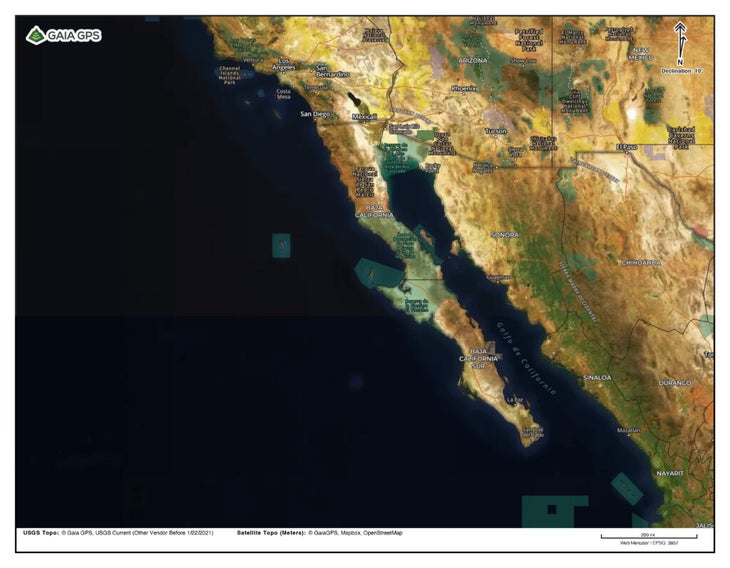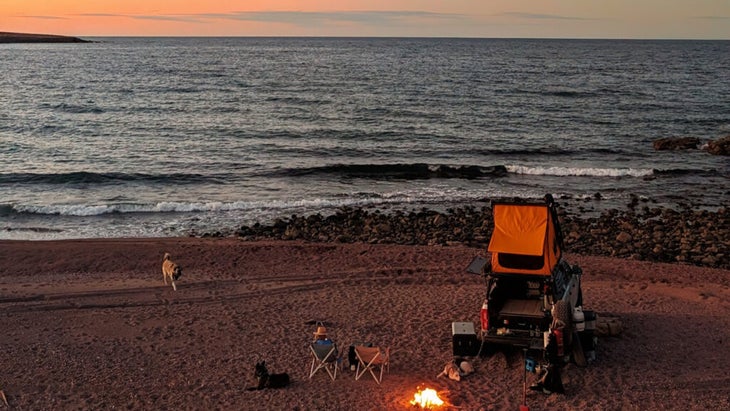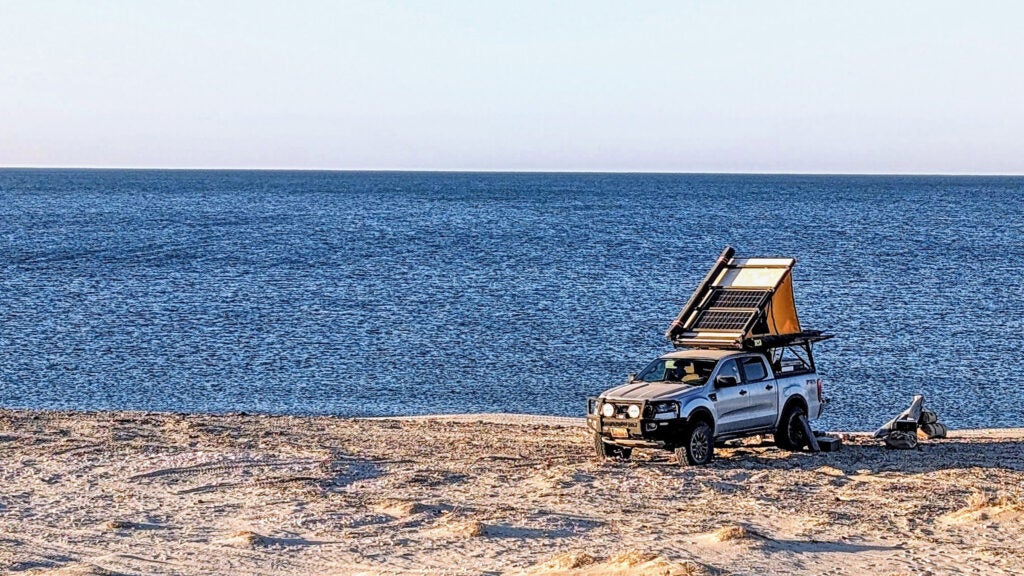No products in the cart.
Outdoor Adventure
Is it Still Safe for Me to Camp in Baja California?
On May 3, authorities in the Mexican state of Baja California discovered the bodies of three surfers—two Australians and one American—who had been missing for a week. Authorities announced the arrest of three people in connection with the alleged murder.
The crime has generated headlines and intense media scrutiny around the world, turning a spotlight onto the Baja peninsula and the infrequent-but-shocking collisions between its beautiful, austere landscapes and the violence occurring by its border with the United States.
Is Baja more dangerous than it used to be? Is it still safe to camp there?
For me, those questions are personal. I’ve been visiting the peninsula regularly for over a decade to go fishing, off-roading, and camping across its remote beaches, deserts, and mountains. I married my wife there just before the pandemic was declared in 2020. We spent our honeymoon driving from Montana down to Todos Santos and back, camping along the way. Part of the region’s draw for us is its demand for personal reliance and the opportunity to test ourselves.
While my wife and I have never had even a whiff of trouble, we do know people who have experienced violence. Among them is Ron Gomez Hoff, who runs the popular TalkBaja website and its multiple associated social media groups. TalkBaja’s online community is an essential resource for people traveling and living in Baja, and Hoff has lived there for the last 24 years. He married into a Mexican family, and lives as part of the local community outside a small town on the peninsula’s Pacific coast.
In an editorial addressing the murders, Hoff shared his experience with violence, telling the story of a time when he and his wife were attacked by criminals near their home—and left for dead.
It’s not just Hoff’s personal experience that’s relevant here. TalkBaja’s main Facebook group is where news of the surfers’ disappearance first broke when the Australians’ mother posted photos of her sons and their friend, seeking help. Hoff sits at the epicenter of information sharing for the region. If there’s anyone who can authoritatively weigh in on the question at hand, it’s him.
“There’s nowhere you can go in the world today that’s totally safe,” Hoff told me. “But down here there are two things working against each other. You’ve got smaller police forces with limited budgets, and then you add to that the fact that the vast majority of this large peninsula is off-grid, it’s remote, there are few paved roads, and there’s no cell phone signal in most places. You can drive hundreds of miles without even seeing a gas station.”
Measured in a straight line, from the U.S. border in the north to Los Cabos in the south, the Baja Peninsula is about 760 miles long. The drive along Highway 1 from Tijuana to San Jose del Cabo is over 1,000 miles. Throughout most of that distance, that highway is barely two lanes wide, irregularly paved, and is so rough and remote that it presents more danger than most Americans have likely ever before experienced.

There are also two states on the peninsula—Baja California and Baja California Sur. The former, which is closer to the U.S. border, contains cities like Tijuana, Ensenada, Mexicali, and Tecate, which have some of the highest rates of violent crime in all of Mexico. South of Ensenada, it’s nearly a 400-mile drive to the border with Baja Sur, then another 260 miles from there to Loreto, a seaside town of 20,000 residents on the peninsula’s east coast which has seen two murders in the last year, a much higher rate than is typical there.
Is the murder rate in Tijuana applicable to a remote beach in the same state, 300 miles south? Of course not. But Hoff said it’s equally inaccurate to look at the very low murder rate for American tourists visiting all places in Mexico, and conclude that Baja is entirely safe.
“Mexico had 33.5 million American visitors in 2022, and only 46 of those were murdered,” said Hoff. At first glance, that represents a lower murder rate than north of the border.
“But murder rates are calculated in homicides per-100,000 people per-year,” Hoff continued. “An average tourist is here for three days. So you’ve got to take the 46 murders, multiply it by 365, and divide it by three.”
Doing that math takes the homicide rate for Americans in Mexico from 0.14 to 17.5 per-100,000 people. In 2022, the overall murder rate in the U.S. was 6.8 homicides per 100,000 people.
“Baja has a reputation as a place that is very remote, and it is,” Hoff continued. “But no matter how remote you get, there’s always somebody around, and that somebody is not always a good guy.”
Hoff said that’s a change he’s witnessed during his time visiting and living in Baja, explaining that an amendment to the Mexican constitution in 1991 that permitted ejido land (a type of communal agriculture land that’s widespread on the peninsula) to be privatized has led to a booming number of small farms and similar being constructed, some in extremely rural areas.
That’s something my experience backs up. I’m a skilled off-road driver who builds my own 4x4s into custom vehicles capable of unsupported travel through extreme terrain, and yet everywhere I’ve been in Baja—even on the other side of really challenging trails—I’ve encountered people.

“You’re just not alone anymore,” Hoff continued. “When you see somebody out there these days they’re either working at a fish camp or ranch, they’re a foreign tourist because Mexican tourists won’t go out there anymore, or they’re a malandro (best translated as ‘bad guy’).”
Hoff went on to share information he’s gathered from local law enforcement and other sources over the decades. Lower levels of cartel operations—drug growing or production sites, or smuggling waypoints—are often staffed by the local equivalent of freelancers. Sometimes they might be busy working, and sometimes they might be between jobs. Because those operations take place in remote areas, that means you could come across malandros with free time on their hands pretty much anywhere. He also said that should you inadvertently find yourself camping in proximity to a cartel operation, they may send people to keep an eye on you, to make sure you don’t pose a threat.
Despite the large number of contacts, friends, and people I know in the Mexican tourism industry, no one wanted to discuss the murders or even safety protocols. People I’ve known for years ghosted me when I asked them. But Hoff’s assessment was backed up by conversations I had with Mexican friends born on the peninsula. I spoke to three of them—locals in the surfing community who told me they did not want to be named in this story.
Instead of sharing their thoughts on crime trends, they gave me practical advice for how to avoid problems in Baja. One, a surfer who recently had their first child, said that they no longer camp in unfamiliar areas, and where possible, try to stay on private land owned by friends or family. Others shared various strategies or approaches to determining areas in which they will or won’t camp that essentially amount to the same advice.
My local sources were reluctant to speak about criminal activities on the record, too. But these conversations are still fruitful. They focus less on an overall assessment of safety either historical or current, and instead immediately dive into the ins and outs of avoiding crime and violence while traveling the peninsula.
“Tell people to use paid-for campgrounds,” one of those friends told me. “That way they’re not only contributing to the local community, but you’re for-sure safe in those.”
I asked Hoff if simply finding a good campsite before nightfall, and making sure no one was around, would reduce that risk. That’s always been my strategy, and I wanted to run it past someone with much more experience.
Hoff told me he wouldn’t recommend winging it anymore, as that can get you into trouble.
The U.S. State Department last updated its longstanding travel advisories around the peninsula in August 2023. Those include a “Reconsider travel” warning for Baja, “due to crime and kidnapping,” and an, “Exercise increased caution due to crime,” for Baja Sur.
“Travelers should remain on main highways and avoid remote locations,” the State Department continues in the advisory. “Transnational criminal organizations compete in the border area to establish narco-trafficking and human smuggling routes. Violent crime and gang activity are common.” It goes on to order that U.S. government employees avoid driving after dark in areas of Mexico adjacent to the border.
“If you want to remote camp safely today, you need to do a lot of research,” Hoff continued. “And I don’t mean look at stuff people posted 10 or 20 years ago, you need to look for something that’s been posted in the last 30 to 60 days about that spot. And don’t just look for one source, find sources that have multiple people commenting on them, supporting or disagreeing.”
Multiple resources exist right now for people looking for good, remote campsites and other areas in Baja. I reference iOverlander, which is full of user generated content reviewing and locating campsites, taco stands, hostels, and similar. BajaNomad is a forum for the same that’s been operating for decades. Friends frequently share coordinates for spots they’ve stayed in or traveled through.
And there’s Hoff’s own TalkBaja, TalkBaja Road Conditions, TalkBaja Weather, and now, Safe Camping in Baja Mexico, a private Facebook group he started just this week, in response to the murders.
“It’s been a long-standing tradition for some of you to keep your favorite remote camping spots a secret but in light of recent events, the time has come for us to come together as a community and share what we know—good and bad—about the different off-road campsites down here in an effort to create a pool of shared knowledge,” Hoff wrote in a post introducing the Safe Camping group.
Despite the recent murders, Hoff believes that information sharing forums like his Safe Camping group will help future travelers and campers stay safe.
“Something changed with this event, and I think it has to do with the amount of coverage it has gotten,” he said. “It’s exponentially greater than other similar events we’ve seen in the past.” Not only did word of the missing surfers break on TalkBaja, but it was followed by multiple eyewitness accounts that tracked their movements in the run up to the murders, described the location and crime scene, and even connected the murderers to another missing persons case.
Despite the increased availability of information on crime and safety in Baja, Hoff believes the murder could become a pivotal moment for tourism on the peninsula.
“Because there’s been so many details provided outside of official sources, I think people are really seeing a detailed story of what these guys went through,” Hoff said, “And people are going, ‘that could be me.’ That’s really hitting home for a lot of travelers.”
For safer travel on the peninsula, you can always go to tourist centers with lower crime rates.
I reached out to the Baja D.A.’s office and the Baja California Tourism Board and its local representatives in Ensenada, Mexicali, and Rosarito for comment, but at press time have not received a response.
Source link

